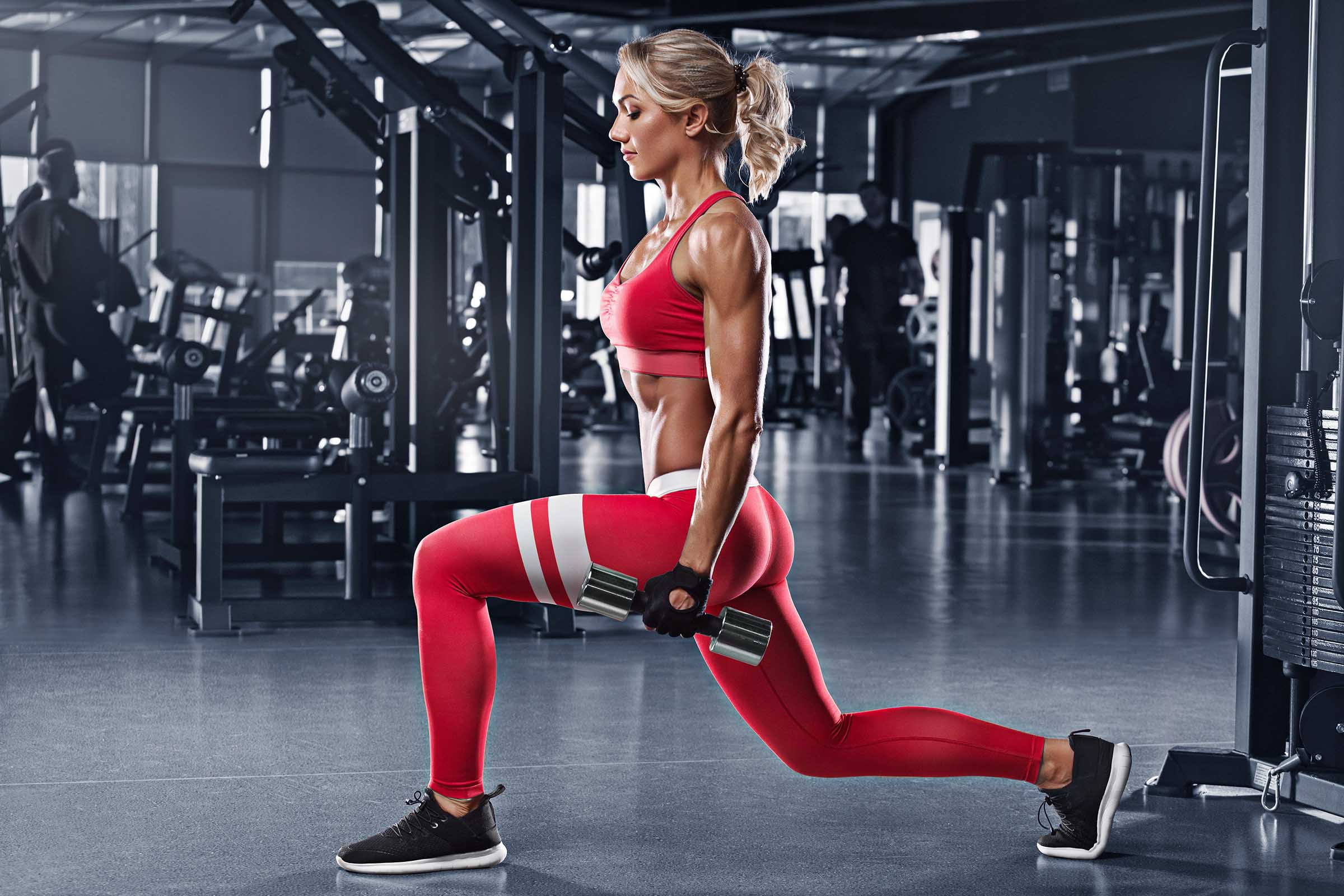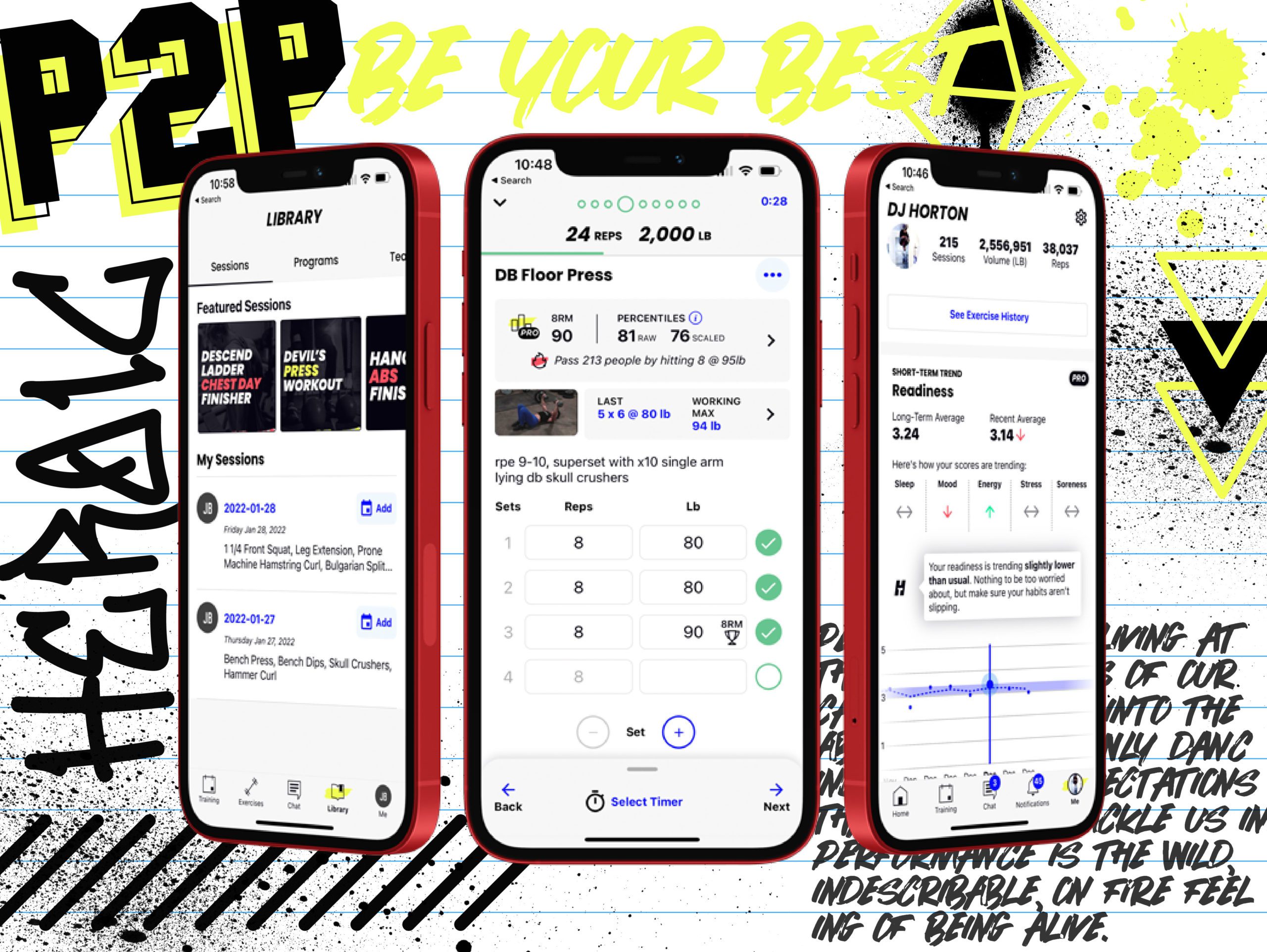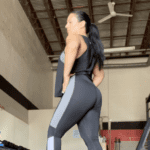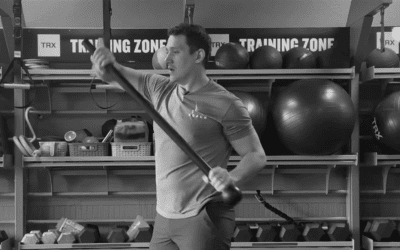How To Do Lunges: Technique, Tips & Variations

Sari Terranova is a total supermom, CPT, and nutrition coach who introduces women and youth athletes to the power of weightlifting, bodybuilding, powerlifting, and functional strength training. She’s got 20 years of classroom teaching experience and a lifetime of love for college football. In this blog, she’ll explain how tempo training can break your plateaus and bring your strength training to new levels.

Love to Loathe the Lunge
When my clients walk into the gym and see lunges in their programming for that day’s session, they all give me that same pleading look (second only to the why-do-you-hate-me/who-hurt-you look I get when I throw in a battle rope finisher on push day).
Let’s face it: lunges suck while you’re doing them. But it’s the kind of suck that you love to hate — you feel like an absolute warrior after that burn. Accomplished. Like you’ve been through something and come out victorious.
Lunges are simple and you can do endless variations without any equipment at all. Their versatility allows you to hit a variety of muscle groups by changing the direction or plane of movement. While they are obviously leg-dominant, lunges also can offer great benefits in terms of core strength development, ankle and hip mobility, and yes, they can even count as sneaky cardio.
As a unilateral movement (the training of which tends to be lacking in many programs), lunges can also help identify and correct muscle imbalances, improving overall balance and core stability. This translates greatly to heavier loads on bilateral compound lifts. Lunges also lend themselves well to progressive overload since you can modify weight, rotation, tempo, and plane of movement.
Whether your goal is strength, hypertrophy, power, mobility, or general athleticism, there is a place for the loathed yet legendary lunge in your fitness program.
Get to Know Your Glutes: Muscles Worked When Lunging

While lunges employ the entire lower body and most of the posterior chain, the standard lunge primarily works the glute max, hams, quads, calves, and core. Remember that the derriere is composed of three major muscles: the gluteus maximus, gluteus medius, and gluteus minimus.
Different variations of the lunge recruit specific bum muscles as primary movers. For example, the lateral lunge engages the glute med, glute min, and hip adductors to a larger degree. While the glute max does most of the work in a sagittal (forward/backward) plane (since it is largely responsible for hip extension), the glute med and min are activated for frontal plane movements (as in abduction where the leg is moved away from the body) and stabilize the hips during unilateral leg movements.
If you want to bias your quads, hams, glutes, calves, or core, check out the variations below and integrate those specific lunges into your programming accordingly.
How to Do a Lunge
1. Stand with your feet about hip-width apart, stacked under your hips.
2. Take a core-bracing breath, keep a neutral spine and neck, and step forward (roughly 18-24 inches) with your right foot, bringing your left knee close to the ground. Some coaches will have you tap the ground with your knee. Keep your abs tight with your right quad and left shin parallel to the floor and your knees in line with your ankles. Both knees should be bent at about 90 degrees with your weight planted on your front foot. Maintain your balance in your standgin foot “tripod”, keeping your back heel off of the ground.
3. Push through your right heel (not off your back foot) to hinge your hips forward and return to starting position.
4. You can repeat all reps in your set on one leg before switching to the other side or do alternating lunges.
You Work too Hard to Not See Progress
Find Your Perfect Training Plan
Options for Every Goal
Training plans from real coaches covering any goal, fitness level, and number of sessions per week.
The Best Coaches
Get coached by the best. Olympians, ex-NFL stars, Titan Games Winners, Sport Scientists and more.
Starting at $1/ day
With many options including a free 7 day trial, you can try out programming before you commit.
Variations For Extra Glute, Quad, & Hamstring Work
Front Foot Elevated Reverse Lunge
If you want to take the pressure off of your knees and favor your glutes and hammies, the front foot elevated reverse lunge is a great option. This variation also requires increased core engagement as you need to maintain hip alignment and balance as you step backward off of an elevated surface.
To perform this lunge, start by standing on a step or bumper plate in the standard lunge starting position. Brace your core, keep your right foot planted firmly and step back onto the ball of your left foot.
Squat down until your right quad and left shin are parallel to the floor and your left knee nearly touches the ground. Don’t rest your weight on your back foot. Instead, push through the heel on your right foot to return to the starting position.
Hover your left foot over the box before extending your leg behind you again for the next rep. Repeat your reps for each leg before switching to the other leg.
Too Easy? For an added challenge, hold a kettlebell goblet style or dumbbells at your sides with a neutral grip. To really crush your core, hold an EZ Bar or preloaded barbell in a front squat or Zercher hold.
Step-Up to Reverse Lunge
Depending on the height of the box you use, this lunge will target quads (lower box) or hams (higher box). A real test of single leg stability, this movement is best done slowly for beginners. But if you’re able to maintain balance and increase tempo, this move can also provide serious cardio benefits.
Stand facing the box in a standard lunge beginning stance and step up firmly onto the box with your right foot. Push through your right foot on the box (not off of your back foot) to drive your left knee up to your waist and return your left foot to the floor. That’s the step-up portion.
Once your left foot hits the floor, bring your right leg back into a reverse lunge position. Rest on the ball of your right foot for a touch (that’s one rep) before driving your left foot through the floor to propel your right foot back on top of the box. Repeat your reps for each leg before switching to the other leg.
Walking Lunges
When my own coach at Bearfit Athletics, JD “The Bear” Berry, wants to lovingly torture me, we finish leg day with 100 walking lunges and 100 kettlebell swings. That couplet will fatigue your whole posterior chain, I can promise you that.
You perform a walking lunge the same way that you perform a standard forward lunge except, well, you just keep going Forrest Gump style until you can’t anymore.
Feeling Spicy? You can make walking lunges even more challenging by adding weight (vest, dumbbell or kettlebell carry, barbell on the shoulders, holding a kettlebell or med ball goblet style, etc), or just by increasing distance/reps and speed.
Parent Tip: I have found that suddenly breaking into walking lunges in any public place is a great way to instantly mortify your middle-schoolers if they need a little ego check.
Kettlebell Lateral Lunges
Want to get those outer glutes and inner thighs in the mix? Kettlebell lateral lunges work the quads while also activating those oft under-trained glute med, glute min, and hip adductors.
Begin this movement by standing with your feet together. Hold the kettlebell at your chest in a front rack position with both palms facing you. Keeping the right foot planted firmly, hinge at the hip, push your butt back, and step your left leg out to the side in line with your hips. Land with your left knee bent at a 90-degree angle.
You can also hold the KB suitcase-style in the same hand as your working leg. As you hinge, the kettlebell will lower toward your left ankle, but don’t round your shoulders or try to reach the kettlebell toward the floor; keep your head and spine neutral. Pause for a count in the bottom position, then push your foot into the ground to return to the upright position. Repeat your reps for each leg before switching to the other leg (and feel some serious burn).
Level Up Your Training
With TrainHeroic’s immersive training app
TrainHeroic does everything you wish your old gym notebook could do.
Take the guesswork out of training with built-in exercise instruction and basic training programs. Compete against yourself and others. Track your performance and readiness. Smash your goals.

Variations With Equipment
Heavy Bag Counterweight Static Lunge
If you are looking to incorporate some endurance, lower body strength, core stability, and a serious quad burn into your cardio heavy bag workout, try working some static lunges into your rounds. You can insert them anywhere, but I like to do a three-minute round of 30-second speed (jab/cross combo), 30-seconds power (heavy hooks), and a 30-second static lunge while pushing the heavy bag away from my body.
To complete this movement, get in a lunge position with your nose to the bag (knees bent at 90 degrees, right quad and left shin parallel to the floor) and push the bag up and away from your body, locking out your arms. Hold for 30 seconds, keeping your back, neck, and head neutral. Repeat your boxing intervals and switch legs for the second static lunge.
TRX Curtsy Lunges
You can do curtsy lunges with just your bodyweight, but I like the upper body engagement and increased range of motion that TRX brings to the movement. I can get an extended diagonal stretch with the counterweight of the straps.
The curtsy lunge pummels all three glute muscles and gives you an extra calf pump. Start in a parallel depth squat position with your arms bent at 90-degree angles. Use a neutral grip on the TRX handles with full tension in the straps. Step backward diagonally with your right foot behind your left hip, bending your knee so that it almost touches the ground, and tap your toe to the floor. Push your left foot through the floor to return to starting position. Repeat with the opposite leg.
Expert Tips to Get the Most out of Your Lunge
Rep Ranges:
For all variations, your rep range will be determined by your purpose (strength or hypertrophy) and whether you are adding weight to the exercise. With unilateral leg movements, I tend to keep the rep ranges slightly below what I would normally program for bilateral movements. For example, while I usually back squat in the 8-10 rep range, I perform weighted unilateral squats in the 6-8 rep range during my accessory sets.
Getting Handsy:
Some people like to keep their hands on their hips during bodyweight lunges, but I prefer to keep my hands at my sides in starting position, and then clasp them in front of my chest (prayer position) while lunging. Do whatever works best for your balance.
To Alternate or Not To Alternate:
If balance isn’t an issue for you and you want to increase your heart rate, by all means alternate each step. If your form is not solid yet, alternating legs can lead to clumsy, off-balance, ineffective lunging. Learn to get in a groove and bang them out one side at a time first.
No Circus Acts:
The lunge takes balance, but it is not a circus act. When people try to “tightrope” their lunges (stepping one foot in front of the other rather than in line with the hips), it looks more like a sobriety test than a feat of strength. Think “railroad tracks” instead of “tightrope.”
Bottom line: Lunges are simple, effective, affordable, and you can do them in your living room while binge watching bad reality TV. So quit complaining, embrace the suck, and learn to love them lunges.
Want Training Tips, Exercise Guides & Knowledge Bombs Sent to Your Inbox?
Sign up for the FitNerd newsletter from TrainHeroic
Related articles
3 Ways to Improve Mobility Without Stretching
Are you still trying the endless foam rolling and stretching exercises to get that deep squat position? We know how important mobility is for great, or even GOOD performance. All professional athletes have some comfortability in end ranges of motion. So, what else do...
The Ultimate Guide to Lunges: Queen of all Glute Exercises
Your glutes are the largest muscle group in your body. They’re responsible for almost everything your legs do—walking, running, jumping, squatting, lunging, and just standing upright. As far as moving through space goes, strong glutes are the bedrock of overall...
A Beginner’s Guide to Steel Mace Training
Author: Jesse Grund
Mace training will make you a better mover without it’s not confining you to a fixed space or predetermined range of motion. Second, it’s an offset load with 80 to 90 percent of the weight in the head. You’re also constantly having to resist rotation, which creates greater core engagement.

Join the community
Sign up for the latest training news and updates from TrainHeroic

About TrainHeroic
Support
Made with love, sweat, protein isolate and hard work in Denver, CO
© 2022 TrainHeroic, Inc. All rights reserved.






